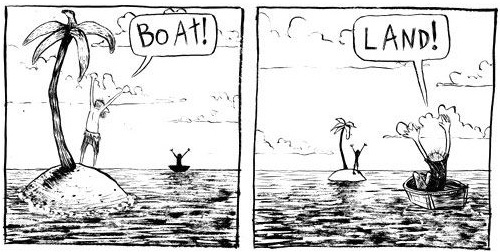Perception and Perspective
Are you trapped on your perceptions of the world, or are you able to step back, thinking holistically and gain perspective?
“The world is full of magical things patiently waiting for our wits to grow sharper.”
Bertrand Russell
Perception vs. Perspective: The Edge in Driving Change and Innovation
If your perception doesn’t offer you perspective, you will be limited to act strategically.
Perception and perspective are not the same, and understanding this nuance can be the difference between strategic success and costly missteps.
Perception is personal, rooted in our individual experiences and biases, while perspective is relational, arising from stepping outside ourselves to consider other viewpoints. You could say that perception is how you interpret the world through your internal filter, whereas perspective is the vantage point that includes others’ realities alongside yours. If you can understand this and position yourself to gain perspective, you will be ahead of majority of people around you.
Perception vs. Perspective in Leadership
Perception is your interpretation of information, the story your mind creates based on your background, and assumptions. It “starts and ends with you,” it’s biased and limited. As a leader, it’s critical to remember that your perception is not an objective truth, only your reality.
Perspective, on the other hand, is a broader framework for understanding situations. It’s the ability to take a step back and view matters beyond your own lens, importantly factoring in how others see the world, feel, and think about a particular situation. Gaining perspective is essentially observing the world from outside yourself. In leadership terms, perspective means elevating to a wider vantage point. Perception is your immediate view, perspective is the bigger view.
“To diagnose a system or yourself while in the midst of action requires the ability to achieve some distance from those on-the-ground events. We use the metaphor of “getting on the balcony” above the “dance floor” to depict what it means to gain the distanced perspective you need to see what is really happening.” Ronald A. Heifetz.
This is the difference between reacting only to your reality versus expanding your understanding to multiple realities.
A leaders who distinguish perception from perspective will gain a significant performance edge. By challenging your initial perceptions and actively seeking diverse perspectives, you inoculate yourself against tunnel vision and bias, and de-risk misunderstanding and misjudging.
Better Decision-Making
Decisions based purely on personal perception can be shortsighted, missing key data or stakeholder concerns. Incorporating multiple viewpoints leads to more informed, more and inclusive and more thoughtful decisions, avoiding costly blind spots.
Stronger Teams and Trust
Relying only on your own perception can cause you to misread others’ intentions and breed conflict. Expanding perspective forces you to pause and consider others’ feelings, responding with empathy, even if you need to make a tough decision. A leader known for seeking others’ perspectives creates a solid foundation for high engagement and high performance.
Innovation and Growth
Perspective is where creativity and learning thrive. Sticking with only what you already “know” (your perception) keeps you in an echo chamber; reaching for new perspectives opens the door to new possibilities. Leaders who actively seek different perspectives are far more likely to spot opportunities and adapt to change quickly.
In essence, understanding perception vs. perspective isn’t a philosophical exercise, it’s a practical leadership skill that separates impulsive action based on a narrow view from strategic action based on a panoramic view.
I invite you to watch this very short video to expand your thinking
Leading Change: Aligning Perspectives to Overcome Resistance
Driving organizational change is one of the biggest test of a leader’s ability to balance perception and perspective. The higher you are in the organization, the broader perspective you have as to why change is important, the strategic need and long-term benefit. However, the lower you go in the organization, experience change through the prism of personal impact, often with a very different perceptions. Research shows that leaders tend to view change as opportunity, necessary for staying competitive, and in fact a clear need to improve efficiencies; whereas many employees perceive change as a threat, to their routines, to their careers, even to job security.
Neither view is “wrong,” they’re different perceptions based on different vantage points, and the leadership challenge is to bridge this perception gap with perspective. That means stepping into employees’ shoes to fully understand their concerns and context, rather than quickly jumping to consider them as resistance or negativity.
“Adaptive leadership” experts urge leaders to work both in and above the fray, to get on the “balcony” and see the broader context of organizational dynamics, in most cases created by themselves. Do listening tours, open forums, reverse mentorship and have individual candid conversations with direct questions such as “what worries you?,” “how do you see this change?” to gather different perspectives from all levels before and during a change initiative. When employees feel heard, leaders can address fears openly (job security, roles changes, training needs…) and tailor the change narrative to resonate with those perspectives. Empathetic communication is acknowledging how the change looks through your team’s eyes, critical to build trust and reduce resistance.
Never assume, no matter how well documented and explained, that your perception of a “necessary change” is automatically shared by the organization. Actively seek out the perspective of those impacted. Listen, validate, and adapt your implementation plan accordingly. Aligning your leadership perspective with your team’s perceptions to find common ground for a smoother, faster adoption of change.
Exceptional change leadership is as much about taking note of emotional perspectives as it is about strategic planning and execution.
Leading Innovation: Perspective as the Catalyst for Breakthroughs
Innovation by nature requires escaping one’s own perceptions. Many projects fail because leaders fall in love with their own product or way of doing business, failing to see it from the customer’s perspective and ultimate experience. Perspective is the antidote to myopia. Relying only on your internal perception gives no real competitive advantage, it’s the same view everyone inside your bubble has, and it disconnects you from the reality others experience.
Satya Nadella, a leader I admire, CEO of Microsoft, famously credits empathy as “a key source of business innovation,” noting that innovation springs from understanding customers’ unmet and unarticulated needs. By pushing his teams to grasp the world through customers’ eyes, Nadella reignited innovation in a once-stagnant company. Microsoft’s renewed focus on customer perspective under his leadership led to more customer-centric products and a cultural resurgence in creativity. In Nadella’s words, “Empathy makes you a better innovator,” because it forces you to see opportunities that a self-centered viewpoint would miss.
Leading innovation means institutionalizing perspective-taking.
Help your Team Pivot from Perception to Perspective
Understanding the concept is one thing; embedding it in your team’s behavior is another. Here is a pragmatic framework you can use to coach people to recognize when someone is stuck in perception and how to shift toward perspective:
Name the Perception:
In meetings, train your team to first identify their initial take on an issue as exactly what it is, an individual perception, not gospel truth. Encourage language -however silly it may sound at first- like, “My perception is that this project is on track,” which leaves room for others to chime in. Simply acknowledging the subjective component can diffuse the egos and open the door to dialogue.
Ask Probing Questions:
Teach your team to pause and ask expansive questions before reacting or deciding. For example: “What else could be going on here that we haven’t considered?” “How might our customers (or team, or another department) see this situation?” Questions like these compel people to step outside their own preliminary conclusions and be forced to gather more information. You could make a rule that no major decision should be made without 1, having played devil’s advocate and 2. discussing pro / cons of an alternative perspective.
Switch the Lens
Instill the habit of perspective-switching. This can be as simple as role-playing, “Imagine you’re the client hearing this pitch, what’s your reaction?” or “If I were new to this company, how might I view our strategy?” Build your team’s mental muscle of viewing problems through different lenses (customer, competitor, front-line employee, etc.) Over time, this should become the operating norm, leading to more well-rounded thinking.
Diversify the Input
Make it standard practice to bring diverse perspectives into decision-making. This might mean cross-functional project teams, seeking counsel from an external advisor, or simply encouraging quieter team members to speak up more regularly. When people hear more often viewpoints that challenge their own, they learn to spot when someone is stuck in a narrow perception and can gently push the group toward a broader view. A culture of “respectful and creative friction” where team members can openly say, “I have a different perspective on this, and here is why” is the hallmark of a high-performing leadership team.
Pause and Reflect
Finally, you can embed a discipline of pausing before final decisions. A short but deliberate pause, a few minutes inside the meeting or an overnight pause to reconnect the next day, can create the space to consider alternate angles that may have been overlooked or that despite the great debate, needed just that extra time to sink in and be seen with more clarity. In most fast-paced environments this will not be accepted, but I believe it is a mistake, because it is precisely in those pauses that intuition catches up with information. Ten more minutes or additional 24 hours will not change anything in terms of speed, however the pause can change everything.
All this can be synthesized in a simple but effective framework:
acknowledge perception → ask → switch lenses → gain perspective → include diverse views → pause to reflect → decide.
Train your team to habitually distinguish personal perception from broader perspective.
Conclusion & Call to Action
In today’s complex business environment, the difference between perception and perspective isn’t academic, it’s leadership gold. Whether you’re leading change and transformation, or incubating the next innovation, success will hinge on seeing the whole board, not just the pieces in front of you. High-performance leaders constantly ask: Am I reacting from a limited perception? How can I broaden my perspective?
The call to action this week is simple but powerful: challenge yourself and your team this week to put perspective into practice. In your next meeting, pick a live business challenge and consciously apply the framework above before choosing a path.
Remember, what you see is only part of the story, and what others see matters just as much. The competitive advantage goes to those leaders with the humility and clarity to look beyond their own lens, to step onto the balcony to expand their view, to the coach that abandons the side of the field and seats for a while in a regular place where fans have to watch the game.
P.S. Before I go, here you have “The Treat,” where I share some of the music that kept me company while writing … I had the opportunity years ago to see Diana Krall live, not in Paris, in Indianapolis, but same concert. Enjoy as you bid farewell to this post
“Lead yourself, Learn to live. Lead others, Learn to Build.”
If you enjoyed reading this post consider subscribing to the newsletter for free, joining the community and sharing your thoughts.




